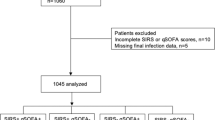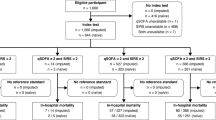Abstract
Systemic inflammatory response syndrome (SIRS) is a frequently encountered complication seen in intensive care unit patients and remains a common cause of mortality. Assessing prognosis of those becomes a priority and indeed we have various efficient scoring systems for the same. However they use enormous data and involve complex calculations for scoring. We intended to find a simple, inexpensive, accurate diagnostic tool of certain markers to predict mortality outcome among critically ill SIRS patients and to evaluate their efficiency in comparison to Acute Physiology and Chronic Health Evaluation II (APACHE II) scoring system. Eighty-seven patients were selected and general hepatic, renal and urinary investigations were done for them at 24 h of admission and were followed up for a period of 4 weeks from admission date to classify them as survivors and non-survivors. Twenty-one percent patients had succumbed to death during study period. Urine albumin–creatinine ratio, alanineaminotransferase, aspartate aminotransferase and prothrombin time/International Normalized Ratio were found to be correlating with APACHE II scores and mortality significantly. Specific individual cut-offs were found for these parameters and were combined to form combined predictors which showed good discrimination (AUC = 0.715) and good calibration (p = 0.811) with specificity of 98.6% in predicting mortality. SIRS patients falling above combined predictor’s cutoff are 54 times more likely to have an unfavorable outcome compared to the ones below. Overall predictive accuracy of first day combined predictors was such that within 24 h of ICU admission 87% of ICU SIRS admissions could be given a risk estimate for hospital death.
Similar content being viewed by others
References
Brun-Buisson C. The epidemiology of the systemic inflammatory response. Intensive Care Med. 2000;26(1):64–74.
Angus DC, Linde-Zwirble WT, Lidicker J, Clermont G, Carcillo J, Pinsky MR. Epidemiology of severe sepsis in the United States: analysis of incidence, outcome, and associated costs of care. Crit Care Med. 2001;29(7):1303–10.
Bone RC, Balk RA, Cerra FB, Dellinger RP, Fein AM, Knaus WA, et al. Definitions for sepsis and organ failure and guidelines for the use of innovative therapies in sepsis. Chest J. 1992;101(6):1644–55.
Rapsang AG, Shyam DC. Scoring systems in the intensive care unit: a compendium. Indian J Crit Care Med. 2014;18(4):220–8.
Knaus WA, Draper EA, Wagner DP, Zimmerman JE. APACHE II: a severity of disease classification system. Crit Care Med. 1985;13(10):818–29.
Kane SP. APACHE II Calculator [Internet]. CincCalc.com. [cited 2014 Mar 20]. http://clincalc.com/IcuMortality/APACHEII.aspx.
Nelson GE, Mave V, Gupta A. Biomarkers for sepsis: a review with special attention to India. Biomed Res Int. 2014;2014:264351.
Blow O, Magliore L, Claridge JA, Butler K, Young JS. The golden hour and the silver day: detection and correction of occult hypoperfusion within 24 h improves outcome from major trauma. J Trauma. 1999;47(5):964–9.
Szabo G, Romics L Jr, Frendl G. Liver in sepsis and systemic inflammatory response syndrome. Clin Liver Dis. 2002;6(4):1045–66.
Harbrecht BG, Zenati MS, Doyle HR, McMichael J, Townsend RN, Clancy KD, et al. Hepatic dysfunction increases length of stay and risk of death after injury. J Trauma. 2002;53(3):517–23.
Brun-Buisson C, Meshaka P, Pinton P, Vallet B, EPISEPSIS Study Group. EPISEPSIS: a reappraisal of the epidemiology and outcome of severe sepsis in French intensive care units. Intensive Care Med. 2004;30(4):580–8.
Marshall JC, Cook DJ, Christou NV, Bernard GR, Sprung CL, Sibbald WJ. Multiple organ dysfunction score: a reliable descriptor of a complex clinical outcome. Crit Care Med. 1995;23(10):1638–52.
Iskander KN, Osuchowski MF, Stearns-Kurosawa DJ, Kurosawa S, Stepien D, Valentine C, et al. Sepsis: multiple abnormalities, heterogeneous responses, and evolving understanding. Physiol Rev. 2013;93(3):1247–88.
Nesseler N, Launey Y, Aninat C, Morel F, Mallédant Y, Seguin P. Clinical review: the liver in sepsis. Crit Care. 2012;16(5):1–8.
Tsiotou AG, Sakorafas GH, Anagnostopoulos G, Bramis J. Septic shock; current pathogenetic concepts from a clinical perspective. Med Sci Monit Int Med J Exp Clin Res. 2005;11(3):RA76–85.
Haraldsson B, Nystrom J, Deen WM. Properties of the glomerular barrier and mechanisms of proteinuria. Physiol Rev. 2008;88(2):451–87.
Zhang Z, Lu B, Ni H, Sheng X, Jin N. Microalbuminuria can predict the development of acute kidney injury in critically ill septic patients. J Nephrol. 2013;26(4):724–30.
Dennen P, Douglas IS, Anderson R. Acute kidney injury in the intensive care unit: an update and primer for the intensivist. Crit Care Med. 2010;38(1):261–75.
Shemesh O, Golbetz H, Kriss JP, Myers BD. Limitations of creatinine as a filtration marker in glomerulopathic patients. Kidney Int. 1985;28(5):830–8.
Moran SM, Myers BD. Course of acute renal failure studied by a model of creatinine kinetics. Kidney Int. 1985;27(6):928–37.
Thorevska N, Sabahi R, Upadya A, Manthous C, Amoateng-Adjepong Y. Microalbuminuria in critically ill medical patients: prevalence, predictors, and prognostic significance. Crit Care Med. 2003;31(4):1075–81.
Gosling P. Microalbuminuria: a marker of systemic disease. Br J Hosp Med. 1995;54(6):285–90.
Holness L, Knippen MA, Simmons L, Lachenbruch PA. Fatalities caused by TRALI. Transfus Med Rev. 2004;18(3):184–8.
Popovsky MA. Transfusion-associated circulatory overload: the plot thickens. Transfusion (Paris). 2009;49(1):2–4.
Norda R, Tynell E, Akerblom O. Cumulative risks of early fresh frozen plasma, cryoprecipitate and platelet transfusion in Europe. J Trauma. 2006;60(6):41–5.
Walsh TS, Stanworth SJ, Prescott RJ, Lee RJ, Watson DM, Wyncoll D, et al. Prevalence, management, and outcomes of critically ill patients with prothrombin time prolongation in United Kingdom intensive care units. Crit Care Med. 2010;38(10):1939–46.
Author information
Authors and Affiliations
Corresponding author
Ethics declarations
Conflict of interest
The authors declare that they have no conflict of interest.
Research Involving Human Participants
Ethical Approval for this study has been obtained and all procedures performed in studies involving human participants were in accordance with the ethical standards of the institutional and research committee and with the 1964 Helsinki declaration and its later amendments.
Informed Consent
Informed consent was obtained from all individual participants included in the study.
Electronic supplementary material
Below is the link to the electronic supplementary material.
Rights and permissions
About this article
Cite this article
Srivatsan, R., Asmathulla, S. & Girija, S. Hepatic and Renal Biochemical Markers as Predictors of Mortality Among Critically Ill Systemic Inflammatory Response Syndrome Patients. Ind J Clin Biochem 34, 188–194 (2019). https://doi.org/10.1007/s12291-018-0734-1
Received:
Accepted:
Published:
Issue Date:
DOI: https://doi.org/10.1007/s12291-018-0734-1




